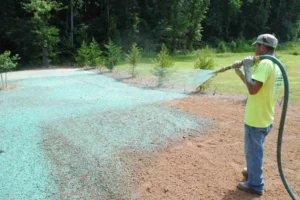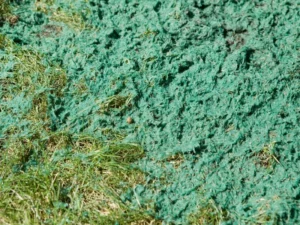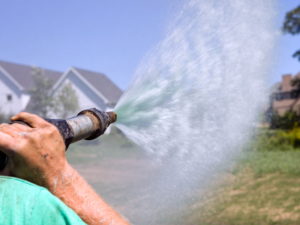Imagine watching a bleak area transform into a beautiful green paradise. It’s as if you’re watching pure magic. And hydroseeding is the key to this amazing transformation. But here’s the real question: how long does hydroseed take to grow?
Hydroseed growth, like a mesmerizing symphony, has its rhythm and pace. You’ll learn all the factors affecting growth, the best time for hydroseeding, the pros and cons, and find out the answer to the question “How long does hydroseed take to grow?”
Each element contributes to this natural spectacle, from the soil’s quality to the weather’s vagaries. So, let us enter the beautiful world of hydroseed growth, where miracles await, and the landscape comes to life with color.
Prepare to be amazed!
What is Hydroseeding?

Hydroseeding is a new lawn-growing technique that is a healthier and more efficient alternative to traditional dry seed spreading or sowing. Hydroseeding, which first appeared in the United States in the 1940s, is also known as hydraulic mulch seeding, hydraseeding, and hydro-mulching.
The approach involves blending seed with water to create a strong blend that can be applied to various surfaces, including residential yards and roadside areas. You can expect speedy and vigorous development for your new lawn if you use hydroseeding.
Hydroseeding Your Lawn

When it comes to hydroseeding, soil preparation is critical to attaining the best outcomes. While professional landscapers frequently perform this stage as part of the hydroseeding process, you must first finish soil preparation if you’re doing it yourself.
Start by tilling the soil to a depth of 6 to 8 inches, removing any debris and rocks from the targeted seeding location, according to Washington State University. Enhance soil quality by tilling 2 to 4 inches of organic materials like compost, peat moss, or manure to enhance drainage. After that, level the area using a rake. If weeds begin to sprout, a pesticide application to the lawn is recommended.
According to the University of California, it is preferable to hydroseed warm-season grasses in mid-spring once soil temperatures reach at least 50 degrees Fahrenheit. Cool-season grasses, on the other hand, should be hydro planted in early October. It’s important to note that fertilizing the young grass is optional because the hydroseed mixture already contains the appropriate fertilizer.
Best Time to Hydroseed your Lawn

Spring or fall are considered the prime seasons for hydroseeding your lawn. The weather is usually mild in these seasons, and the soil retains warmth. These ideal conditions allow grass seedlings to develop deep roots quickly.
The hydroseed germinates faster in the summer season. It is crucial to note that the grass will require more regular watering because of the higher temperatures.
Winter is not a good time for hydroseeding since the grass will remain dormant and not germinate. The grass germinates and grows actively when the weather begins to warm. As a result, it’s better to avoid hydroseeding during the winter and instead concentrate on spring.
How Long Does Hydroseed Take to Grow?
Seed germination should take 10-14 days after hydroseeding. It takes 6-8 weeks to cover the entire grass, with differing growth rates in different regions. The growth rate is affected by factors such as seed combination, hydration, and environment.
Some lawns can sprout in as little as 5-7 days and grow to a height of 3 inches in as little as a month. The germination period varies by grass type, ranging from 5 to 28 days. With adequate care and attention, your hydroseed can fully mature.
Factors that Affect Hydroseed Growth Time

The germination and growth times of various types of grass cultivated from hydroseed differ. The conditions under which the seeds are planted also impact the rate of hydroseed growth. Several important elements influence hydroseed growth time:
- Soil Conditions — Soil composition and quality have an impact on hydroseed success. Tilling compacted soil and doing soil testing assist in ensuring optimal growth.
- Weather Condition — Spring and fall are great times for hydroseeding because of the mild temperatures. Extreme cold or heat can stifle germination or reduce moisture levels.
- Type of Seed — Different grass species have different germination rates. Bermuda grass and Ryegrass germinate quickly, while others take longer.
- Watering — Regular watering is essential for hydroseed establishment. Water 2-4 times each day, adjusting as needed to ensure appropriate moisture for germination.
Advantages of Hydroseeding
- Hydroseeding uses weed-free seed mixtures, preventing weed growth and promoting a healthier lawn.
- Hydroseeding is faster and more convenient than traditional seed spreading.
- Hydroseeding is cost-effective, reducing material and labor expenses.
- Hydroseeds retain water, conserve moisture, and help stabilize slopes.
- Hydroseeding produces high-quality lawns with deep root systems, preventing erosion and weed growth.
Disadvantages of Hydroseeding
- Hydroseeding is most effective when combined with mulching and soil binder.
- Proper irrigation is essential for successful hydroseeding during dry periods.
- Hydroseeding is a cost-effective option for larger areas.
- Accessing remote areas with a hydroseeder may pose challenges.
- Wood fiber hydraulic mulches require a dry period of 24 hours before rainfall to be effective.
How Much Does Hydroseeding Cost?
Hydroseeding costs vary depending on grass kind, soil additives, slope conditions, and accessibility. The cost of grass seeds, soil supplements, additional slope erosion prevention methods, and the work necessary to access the site all influence final costs. You should engage with hydroseeding professionals who can assess your project requirements to acquire an accurate cost estimate.
Seeding vs. Sod vs. Hydroseeding
There are three methods for creating a lawn, each with its own advantages: seeding, sodding, and hydroseeding.
- Seeding — It’s the most cost-effective option, but it takes longer for the grass to develop and fully establish.
- Sodding — This procedure produces speedy results but is the most expensive. It takes less watering and upkeep but has fewer grass selections.
- Hydroseeding — In terms of cost and efficiency, it falls somewhere in the middle. It produces faster results than sowing and gives a greater variety of grass selections.
Conclusion
Several factors, such as soil, weather conditions, types of seed, and the watering technique, determine how long it takes for hydroseed to fully mature. If you’re planning to hydroseed your lawn, you should keep these factors in mind. Also, remember that hydroseeding isn’t a DIY procedure; you should hire a professional to do it.
Contact ProGreen Lawn Services to get your lawn hydro-seeded. We provide our services in Bloomington, Eden Prairie, Prior Lake, Shakopee, and Savage.
Call us at 9529941041 today!
FAQs
-
Does hydroseed grow faster?
Hydroseeded lawns start showing growth within five to seven days and are generally ready for their initial mowing after about 30 days. These lawns grow more quickly than those seeded using traditional methods, owing to the fertilizer content in the slurry mixture.
-
Does hydroseed need sunlight?
Can hydroseeding succeed in shady spots? The answer is both yes and no. While many lawn grasses thrive in full sun, even shade-tolerant varieties require a minimum of three hours of filtered sunlight daily. Keep in mind that the grass might become sparse over time.
-
Can my dog walk on hydroseed?
It’s advised to avoid allowing your dogs or children onto the hydro seeded area until it has fully matured, which usually takes around 8 to 10 weeks.


